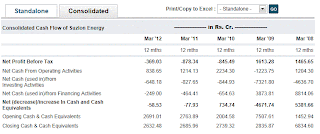Have a look at the below table for Sensex:
We can see that over 22 years, the compounded growth of the Sensex has been at a respectable rate of 14.53% pa. This means Rs.100,000 invested directly in the market would have grown to about Rs. 2,000,000. No stress, no trades, no commissions, no research, no-nonsense.
During this period, too many events have taken place - trade deficit crisis, currency crisis, terrorist attacks, IT bubble, policy scams, financial crisis, the global meltdown; and the policy reforms, growth in corporate earnings, growth in the GDP and the global recognition.
It looks like in the final analysis, positive events driven by the fundamentals beat the negative events. Hence, the march of the Sensex.
We have seen it before in Dec-2011 and Oct-2012. Where do we stand today?
We saw the peak values of 52.6 P/E, 9.4 P/B and 0.51 Dividend yield in April 1992; and the low values of 10.2 P/E, 1.7 P/B and 2.2 Dividend yield in October 1998.
While we do not know when we will see those values in future, today it looks like this:
17.4 P/E, 2.9 P/B and 1.5 Dividend yield.
Compare this to the average values:
21 P/E, 3.7 P/B and 1.4 Dividend yield.
It looks like we are in the range of average values. Is this the buy time then?
The average values may have to be reworked backing out outliers.
Let's have a look at values when the Sensex peaked at 20509 in December 2010:
22.9 P/E, 3.7 P/B and 1 Dividend yield.
There isn't big difference between P/B and Dividend yield of today and December 2010. P/E was a little higher in December 2010 though.
The Sensex is neither very cheap nor very expensive now.
What we need is a set of assumptions for long term investing:
Two options are available:
Be very passive and invest in the market itself. Don't trade, speculate, or predict. Don't track or time the market. OR
If interested and time is available, get into equity research business and play the investing game for long term. It can be fun and rewarding.
We don't just need the new year wishes; we need wishes for the new decade.
We can see that over 22 years, the compounded growth of the Sensex has been at a respectable rate of 14.53% pa. This means Rs.100,000 invested directly in the market would have grown to about Rs. 2,000,000. No stress, no trades, no commissions, no research, no-nonsense.
During this period, too many events have taken place - trade deficit crisis, currency crisis, terrorist attacks, IT bubble, policy scams, financial crisis, the global meltdown; and the policy reforms, growth in corporate earnings, growth in the GDP and the global recognition.
It looks like in the final analysis, positive events driven by the fundamentals beat the negative events. Hence, the march of the Sensex.
We have seen it before in Dec-2011 and Oct-2012. Where do we stand today?
We saw the peak values of 52.6 P/E, 9.4 P/B and 0.51 Dividend yield in April 1992; and the low values of 10.2 P/E, 1.7 P/B and 2.2 Dividend yield in October 1998.
While we do not know when we will see those values in future, today it looks like this:
17.4 P/E, 2.9 P/B and 1.5 Dividend yield.
Compare this to the average values:
21 P/E, 3.7 P/B and 1.4 Dividend yield.
It looks like we are in the range of average values. Is this the buy time then?
The average values may have to be reworked backing out outliers.
Let's have a look at values when the Sensex peaked at 20509 in December 2010:
22.9 P/E, 3.7 P/B and 1 Dividend yield.
There isn't big difference between P/B and Dividend yield of today and December 2010. P/E was a little higher in December 2010 though.
The Sensex is neither very cheap nor very expensive now.
What we need is a set of assumptions for long term investing:
- The government will take the right policies for reforms in the key sectors of the economy;
- The interest rates (and the inflation) will remain at reasonable levels;
- The corporate profits will grow; and
- Positive events will outweigh negative events over the period.
Two options are available:
Be very passive and invest in the market itself. Don't trade, speculate, or predict. Don't track or time the market. OR
If interested and time is available, get into equity research business and play the investing game for long term. It can be fun and rewarding.
We don't just need the new year wishes; we need wishes for the new decade.




































